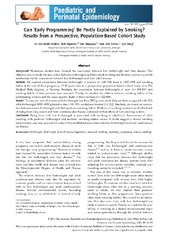| dc.contributor.author | Kvalvik, Liv Grimstvedt | en_US |
| dc.contributor.author | Skjaerven, Rolv | en_US |
| dc.contributor.author | Klungsøyr, Kari | en_US |
| dc.contributor.author | Vollset, Stein Emil | en_US |
| dc.contributor.author | Haug, Kjell | en_US |
| dc.date.accessioned | 2015-08-03T08:28:48Z | |
| dc.date.available | 2015-08-03T08:28:48Z | |
| dc.date.issued | 2015-01 | |
| dc.identifier.issn | 0269-5022 | |
| dc.identifier.uri | https://hdl.handle.net/1956/10186 | |
| dc.description.abstract | Background: Numerous studies have focused the association between low birthweight and later disease. Our objective was to study the association between birthweight and later adult smoking and thereby explore a possible mechanism for the association between low birthweight and later adult disease. Methods: We studied associations between birthweight of women (n = 247 704) born in 1967–1995 and smoking habits at the end of their pregnancy 13–42 years later in a prospective, population-based cohort study from The Medical Birth Registry of Norway. Similarly, the association between birthweight of men (n = 194 393) and smoking habits of their partners were assessed. Finally, we studied the relation between smoking habits of the participating women and the cause specific death of their mothers (n = 222 808). Results: Twenty per cent of women with birthweight less than 2000 g were adult daily smokers compared with 11% with birthweight 4000–4499 g [relative risk = 1.8, 95% confidence interval 1.4, 2.2]. Similarly, we found an association between men’s birthweight and their partners smoking habits. Mothers of smoking women had doubled risk of dying from lung cancer and from cardiovascular disease compared with mothers of non-smoking women. Conclusions: Being born with low birthweight is associated with smoking in adulthood. Associations of adult smoking with partners’ birthweight and mothers’ smoking-related causes of death suggest a shared smoking environment, and may account for some of the established association between birthweight and later cardiovascular disease. | en_US |
| dc.language.iso | eng | eng |
| dc.publisher | Wiley | eng |
| dc.relation.ispartof | <a href="http://hdl.handle.net/1956/17723" target="_blank">Smoking among pregnant women in Norway. Prevalence, self-report validity, and associations to SGA and “early programming” using family and sibling design</a> | |
| dc.rights | Attribution CC BY | eng |
| dc.rights.uri | http://creativecommons.org/licenses/by/4.0/ | eng |
| dc.subject | birthweight | eng |
| dc.subject | fetal origin of adult disease hypothesis | eng |
| dc.subject | maternal smoking | eng |
| dc.subject | Mortality | eng |
| dc.subject | Pregnancy | eng |
| dc.subject | tobacco smoking | eng |
| dc.title | Can 'early programming' be partly explained by smoking? Results from a prospective, population-based cohort study | en_US |
| dc.type | Peer reviewed | |
| dc.type | Journal article | |
| dc.date.updated | 2015-08-03T08:22:59Z | |
| dc.description.version | publishedVersion | en_US |
| dc.rights.holder | Copyright 2014 The Authors | |
| dc.identifier.doi | https://doi.org/10.1111/ppe.12164 | |
| dc.identifier.cristin | 1240132 | |
| dc.source.journal | Paediatric and Perinatal Epidemiology | |
| dc.source.40 | 29 | |
| dc.source.14 | 1 | |
| dc.source.pagenumber | 50-59 | |

